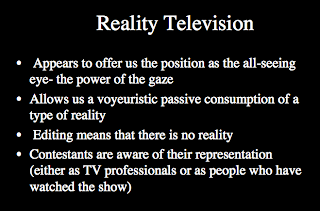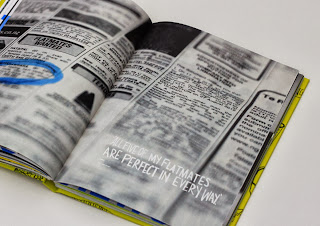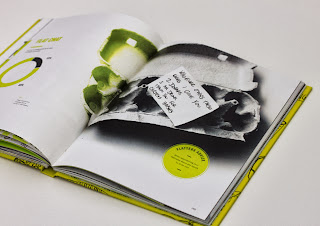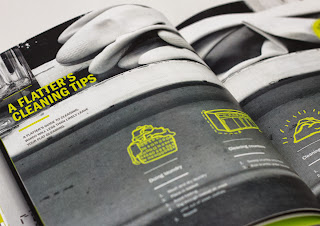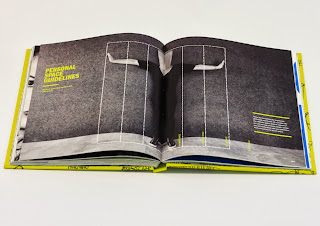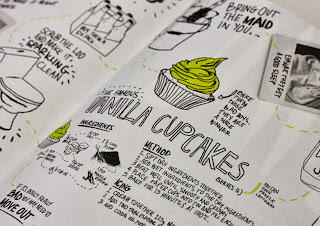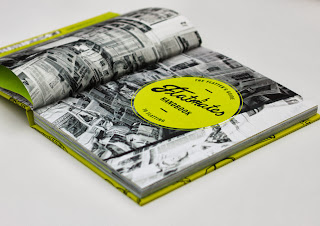Berger is saying that women internalise the gaze. Because of the amount of women's body representations which are around they have started to internalised the gaze.
Hans Memling 'vanity' (1485)
- Odd mirroring of the woman's face.
- A way of the painter painting a nude because it gives him pleasure, planting a mirror in the woman's hand it makes it ok for us to look at her because she is looking at herself.
- 1485 - a statue was around which allowed the Catholic church to punish women for being witches.
The device of the mirror appears in contemporary advertising.
We cannot see her eyes because she is preoccupied with herself - this means that we are allowed to objectify her and look at her differently.
The woman does not challenge the gaze she welcomes it. Her hand over her brow.
The same image but turned on its side gives emphasis on the face.
Berger
makes the comparison :Traditional nude- regarding us coquettishly
VS Manet - ‘Olympia’ (date)
- Olympia transforms a dignified goddess into the simple nakedness of humanity. Olympia does not belong to the world of mythology - Olympia stood “as the first nude to represent modern reality” because she is a prostitute rather than a godess figure
- Shocked Modern society - Olympia is adorned with the trappings of success - jewels / bracelets etc, not the degraded prostitute of popular myth - Courtesan
- Cat is symbol of individual femininity and independence. Olympia ignores the flowers presented to her, probably as a gift to her from an admirer.
Ingres 'Le Grand Odalique' (1814)

The gorilla girls used this image in 1985 and reappropriate it.
Interesting statistics
The mirror reflects her back but is not accurate. We are put in the position of the painting. The man in the background is conversing with her. She is not a part of the Paris society.
- Jeff Wall referred to the image by Manet.
- The woman is copying the vacant look which the woman in the painting is doing.
- He has dived the reflection into thirds using the edge of the mirror.
- Camera is put in the position which Manet would have been in
- The photographer is as far away from the woman as possible - objectifying.
Picture
for Women was
inspired by Edouard Manet's masterpiece A Bar
at the Folies-Bergères (1881–82). In Manet's painting, a barmaid gazes out of
frame, observed by a shadowy male figure. The whole scene appears to be
reflected in the mirror behind the bar, creating a complex web of viewpoints.
Wall borrows the internal structure of the painting, and motifs such as the
light bulbs that give it spatial depth. The figures are similarly reflected in
a mirror, and the woman has the absorbed gaze and posture of Manet's barmaid, while the man is the
artist himself. Though issues of the male gaze, particularly the power
relationship between male artist and female model, and the viewer's role as
onlooker, are implicit in Manet's painting, Wall updates the theme
by positioning the camera at the centre of the work, so that it captures the
act of making the image (the scene reflected in the mirror) and, at the same
time, looks straight out at us.
Coward, R. (1984) The Look - essay about the gaze
- The camera in contemporary media has been out to use as an extension of the male daze at women on the streets.
- The model wearing sunglasses - she is prevented from returning the gaze.
- Caused traffic problems
- Normalisation of a female body in the streets
- No return of the gaze because she is looking down
- Voyeurism: the compulsion to seek sexual gratification by secretively looking at sexual objects or acts; the actions of a Peeping Tom.
- He films the woman in her moment of death. Objectification taken to the extreme
- Classical move
- Eyes are closed, we are allowed to look at the body
- The quantity of images of women is far more than men
-
The issue of male objectification is often raised in gender classes that I have taught. I have heard many men and women suggest that men are now equally objectified in popular culture. Many a people have focused on the Lucky Vanos ads of years past as a sign of advertisers recognizing the desire of women to objectify men in our society. But what is really happening in advertising? Can men be objectified as women? If so, in what frequency is objectification present in ads? The Ads: Consider the number of ads presented in this male trope as compared to other examples of female objectification. It is interesting that when I first began the Web site many years ago, the number of ads in this exhibit were small. Today, there are nearly 60 such ads.Dr Scott A Lucas (genderads.com)
- Every male returns our gaze
- Passive positioning we get with the female body
- Representation of a super power, nothing passive
- Laura Mulvey did not undertake empirical studies of actual filmgoers, but declared her intention to make ‘political use’ of Freudian psychoanalytic theory (in a version influenced by Jacques Lacan) in a study of cinematic spectatorship in narrative Hollywood cinema.
- She looks at the ways which bodies are chopped up in filming - close up shot on woman
- Projecting fantasies
- Females are never the drivers of the film, they do not lead the narrative
Mulvey notes that Freud had referred to
(infantile) scopophilia - the pleasure involved in
looking at other people’s bodies as (particularly, erotic) objects. In the
darkness of the cinema auditorium it is notable that one may look without being
seen either by those on screen by other members of the audience. Mulvey argues that various features of
cinema viewing conditions facilitate for the viewer both the voyeuristic
process of objectification of female characters and also
the narcissistic process of identification with an ‘ideal ego’ seen on
the screen. She declares that in patriarchal society ‘pleasure in looking has
been split between active/male and passive/female’ (Mulvey 1992, 27).
Two
women are trying to cut off a man's head on a bed. Artemisia Gentileschi's
Judith Beheading Holofernes shows a famous Biblical
assassination. The sword-woman is Judith, a Jewish lady. The other woman is her
maid, Abra. Their victim is Holofernes, the Assyrian general.
-
Judith has got into his tent and got him deeply drunk. To judge from his naked body in the sheets and from her slipped dress, she's got him into bed too, before he passed out and they could get to work. Gentileschi pays attention to her story.And now the drunk man has woken in the middle of their attack. Candlelight reveals the tight, desperate wrestling of limbs. Judith, she with the blade, is keeping herself at arm's length, partly, as her pursed, slightly averted face suggests, out of a revulsion from the disgusting though necessary job (how many heads has she cut off before?); partly to stay out of the fight, so far as this is possible, because both her hands are needed for leverage, grasping his head by the hair, pushing the blade through his neck.Abra meanwhile tries to hold him down. Her calm and beautiful face is directly above him, looking straight down on to him. Her efficient hospital gestures restrain his thrashing body. They indicate her perfect managing indifference to this creature's battle for life. But both women are ruthless. Judith is disposing of a rat. Abra is drowning kittens.There is plenty of sensation to enjoy, the blood-stained sheets, the flesh. But Gentileschi's emphasis is on how hard it is, how long it can take, to kill someone. She stresses the hows and difficulties. The strain and strength in Judith's parallel arms, driving the sword through spine and gristle, is evident. The visual confusion of plunging arms and gripping hands – whose is whose? – mimics Abra's trouble keeping control of the man, holding one arm down while another breaks free.This violence, in other words, is violent. This outcome is clear, probably imminent, the cut is almost through, the head will come free. But that's not how the picture makes you feel. There is no sense of a clean gesture, a chop. They're in the thick of it, the carving blade still in the neck, their bodies tangled with his like lovers. The killers are intimately implicated in their murder.This killing isn't pictured as a heroic deed, a sword raised to strike, a head raised as a trophy. It's an ongoing business, which never seems to end. Muori, dannato! Muori!, as Tosca cries in the opera: Die, damned one! And in this painting, the struggle continues.http://www.independent.co.uk/arts-entertainment/art/great-works/great-works-judith-beheading-holofernes-161213-artemisia-gentileschi-1807173.html
- Cindy Sherman
- 1977-79
- She said she wasn't making the work to challenge the gaze.
- Holding the mirror in her hand but facing it down denies us the right to look at her
- It looks staged
- Challenges the gaze
- Untitled film still #7 1977
- Judith holofernes 1989/90 from History portraits
Barbara Kruger
- Uses text which gives the impression of being cut out of a newspaper
- Reference to violence
- Challenges the gaze by using the word 'hits'
Sarah Lucas 'Eating an banana' (1990)
- Humorous - refers to the sexual identification of s banana
- Returns the male gaze
Sarah Lucas 'Fried eggs' (1996)
- No way we are allowed to look at her without a challenge of the gaze
Tracey Emin 'Money photo' 2001
- Some kind of prostitution
Caroline Lucas MP in June 2013
- Challenging page three
- She was asked to remove it because it contravened with the dress code of the house of commons.
- She added: "It does strike me as a certain irony that this T-shirt is regarded as an inappropriate thing to be wearing in this House, whereas apparently it is appropriate for this kind of newspaper to be available to buy in eight different outlets on the Palace of Westminster estate."During the debate, the MP for Brighton Pavilion argued The Sun newspaper's Page Three, which features topless models, should be consigned to the "rubbish bin where it belongs".
The attack of women who are speaking out about the gaze.
Caroline
Criado-Perez (born 1984) is a British
journalist and feminist activist. She has been involved in high profile
campaigns for women to gain better representation in the British media
Mary
Beard- eminent classicist, The Guardian's Hadley Freeman, the Independent's
Grace Dent and Time magazine's Catherine Mayer all said they had received
identical bomb threats on Wednesday.
The woman was due to be removed and replaced with Winston Churchill.
She said it was like removing women from history.
She received lots of abuse on twitter for this.
Lucy Ann Holmes had the same issue with social networking.
Women are removed from the history of Britain.
- Ignores the fact that a woman won the tournament 30 years ago
- Young people are vulnerable
- The body is broken into fragments- could be any female
- Plays on teenagers body consciousness, potentially carrying those perceptions into adult life
Susan Sontag (1979) 'On Photography'
- To photograph something is to apropriate the thing
- Pap images steal shots for personal financial gain
- The publication of these shots creates a market for their passive consumption (mags and newspapers)
- We contribute to the perpetuation of this cycle buy buying the mags, we create the market for our own voyeuristic pleasure
- Our desire is to see the mask of celebrity lifted, and ordinary life exposed.
- This is ultimately what killed Princess Diana
- Big brother offer us a position of power
- We see everything and we decide who stays and who goes
- This is a passive consumption
- Contestants are aware of their representation
Jim Careys character discovers the limits of
his world, that his life is a staged event.
- Born into a reality television show
- Fantasy extension
- It is not just female bodies being gaze upon in Big Brother it is males aswell
- Carrying an image around in our heads of what we think we look like - Berger
- It is a political issue
- Are there challenges to be made to these representations




































